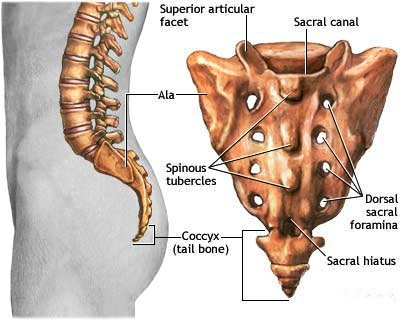
Get your hand back!! The effectiveness of Chiropractic and physiotherapy on Carpal tunnel
September 21, 2015
Pain?? No gain!!
September 29, 2015Coccyx Dysfunction: your osteopath can help !

 Coccydynia, is a fairly rare and relatively poorly understood condition that can cause persistent pain at the very bottom of the spine, known as the coccyx, or tailbone.
Coccydynia, is a fairly rare and relatively poorly understood condition that can cause persistent pain at the very bottom of the spine, known as the coccyx, or tailbone.
Coccydynia symptoms may consist of one or all of the following:
- Pain that is worse when sitting
- Local pain in the tailbone area that is worse when touched or when any pressure is placed on it
- Pain that is worse when moving from a sitting to standing position
- Headache
- Low back pain
The majority of coccyx injuries occur in women because:
- Women have a broader pelvis, which means that sitting places pressure on their coccyx (male anatomy causes them to sit without much pressure on the coccyx)
- Childbirth can also be a common cause of this condition.
There are many reasons this condition can present itself, repetitive strain from cycling, rowing, direct impact from an accident or fall, or simply sitting in awkward or prolonged postures all of which can create pressure or move the tailbone out of its normal place causing pain. This can result in pressuring or pulling on supporting ligaments and nerves causing moderate to debilitating tailbone pain. Due to the strong attachments of the spinal cord to the coccyx, when this pressure occurs the spinal cord is pulled down sharply, often creating a strong pull on its next attachment at the base of the skull which can result in headaches.
Depending on the injury the coccyx can be slightly deviated left or right, or even with some impact injuries be forced into a more anterior position, this can create a lot of different pain presentations which is why a specific and accurate diagnosis is needed to treat coccydynia symptoms.
Treatment of Coccydynia
The best form of treatment for Coccydynia pain is Osteopathic, thanks to its gentle and precise palpation, osteopaths are able to diagnose the position of your spine and the position of your pelvis then apply a rotation or twist to the bones of the pelvis creating tension or a pull on the coccyx and ligaments to help diagnose your pain or discomfort.
Once your pain is diagnosed and the angle or deviation of your coccyx is obtained your osteopath will begin reducing stress on and around the coccyx. This can be done in a variety of ways depending on the patient’s pain presentation or angle of deviation. By reducing the stress around the sacral and pelvic joints, using different fascial techniques aiming at releasing ligament and muscle tension, the osteopath will encourage the structures to relax and wait for the tissues to release.
The purpose is to bring the tailbone back into a better position, helping to create better mobility for the tailbone and reducing pressure or stress to the rest of the spine, but it has to be very gentle and specific to produce the best results.
Osteopaths provide a very gentle and specific treatment for this condition, with accurate diagnosis and treatment patients can sometimes become pain free within a few treatments.



